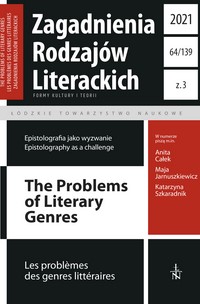Listy pisze Pan tak samo jak książki”. Wokół korespondencji Wiktora Woroszylskiego z Jerzym Stempowskim, Jerzym Giedroyciem i Zbigniewem Żakiewiczem
“You write letters just like books”. On the Correspondence of Wiktor Woroszylski with Jerzy Stempowski, Jerzy Giedroyc and Zbigniew Żakiewicz
Author(s): Maja JarnuszkiewiczSubject(s): Psychology of Self, Source Material
Published by: Łódzkie Towarzystwo Naukowe
Keywords: epistolography; autocreation; correspondence; epistolary subjectivity; Woroszylski;
Summary/Abstract: The aim of this article is to analyze the collection of letters between Wiktor Woroszylski and the writers: Jerzy Stempowski, Jerzy Giedroyc and Zbigniew Żakiewicz. It is based on two volumes of Woroszylski’s letters, published in 2020. The paper reveals a letter as genre, which can be read as an evidence of a writer’s life, a historical document, as well as a commentary on a legacy. The first three parts of the text include an analysis of the collection of letters. It traces the characteristics of the relationships between the correspondents and the main subjects of the conversations along with the crucial writing strategies. The last part covers a wider reflection on the epistolographic work of Woroszylski. Firstly, the key features of the letter as a genre are considered, i.e. its performativity, dialogicality (connected with the relation between “you” and “I”) and at the same time conversion between the personal and textual self. Secondly, the main issue of the paper reveals Woroszylski as an author, a man, a correspondent and an activist but also shows how he manifests himself in the letters. The main purpose is to present Woroszylski as a subject of epistolary writing. It means that he has to be considered as a real person at a specific point in life as well as in the instance related to the situation of the text. It is related to the author’s self-creation in two meanings of this word: self-presentation and self-conceptualization. Nevertheless, the image of Woroszylski remains internally consistent and, furthermore, it is compatible with his biographical and creative portrait. To conclude it must be admitted that his epistolography should be examined among the writer’s other works, because, as a genre, letters refer to the real world and require both textual and non-textual references.
Journal: Zagadnienia Rodzajów Literackich
- Issue Year: 64/2021
- Issue No: 3
- Page Range: 87-102
- Page Count: 16
- Language: Polish

